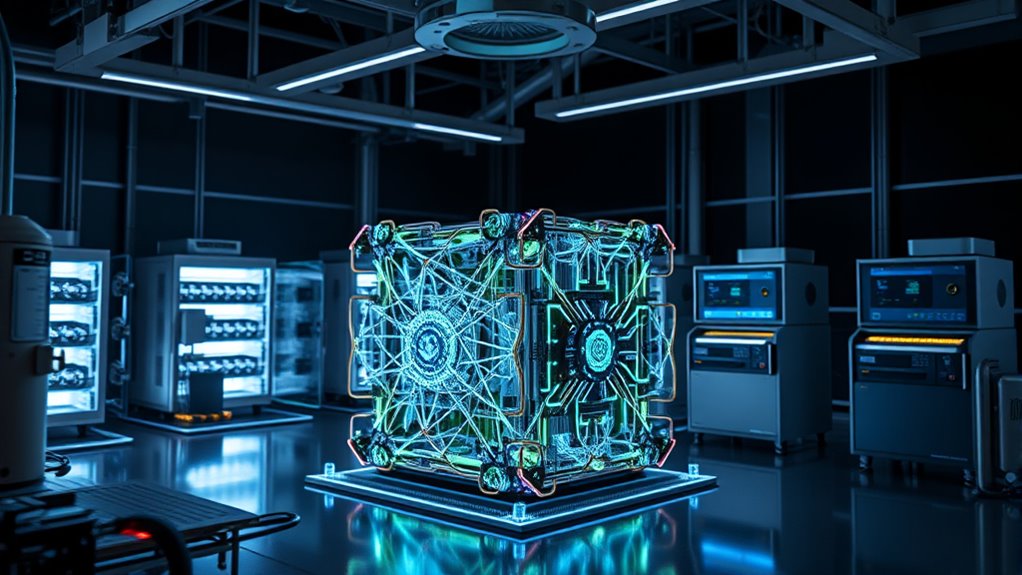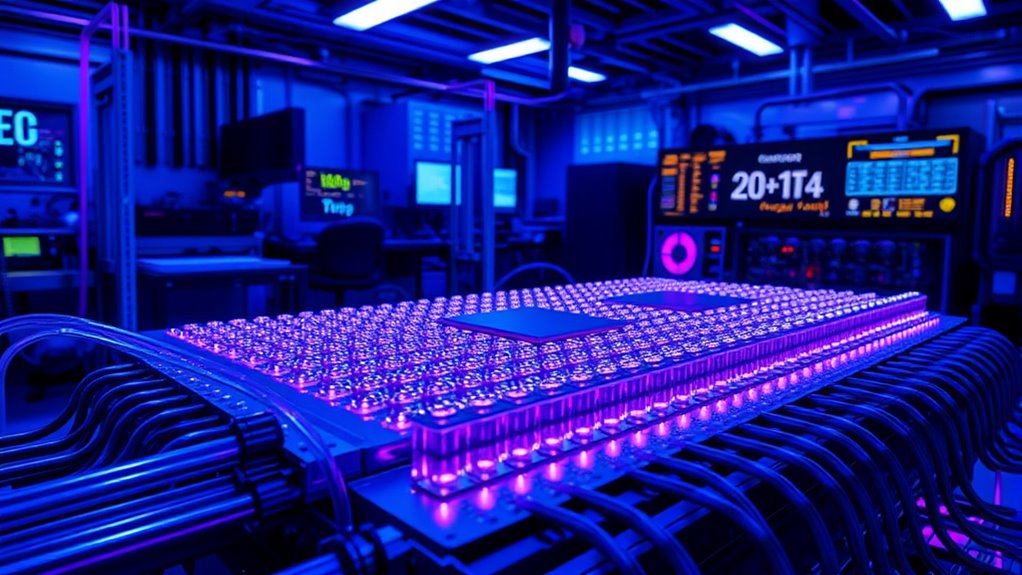Google’s recent achievement of surpassing 1,000 qubits marks a major step forward in quantum computing. It demonstrates the growing power and scalability of quantum systems, moving closer to practical use and quantum supremacy. While more work remains to master error correction and maintain stability, this milestone confirms significant progress toward solving complex problems previously out of reach. If you want to understand how this development impacts the future of technology, keep exploring the details behind this breakthrough.
Key Takeaways
- Google’s quantum computer has surpassed the 1,000-qubit milestone, marking a major achievement in quantum hardware development.
- This milestone indicates increased computational power, bringing quantum systems closer to achieving quantum supremacy.
- The achievement demonstrates progress in scalable, high-capacity quantum systems capable of tackling complex problems.
- Overcoming error correction challenges remains essential for maintaining stability in large-scale quantum computations.
- The milestone accelerates the transition toward practical, fault-tolerant quantum computers with transformative industry applications.

Google has achieved a major breakthrough in quantum computing by surpassing the 1,000-qubit mark, marking a significant milestone in the field. This leap brings you closer to realizing quantum supremacy, where quantum computers outperform classical ones on specific tasks. Achieving such a high qubit count isn’t just about numbers; it demonstrates that quantum systems are becoming increasingly powerful and capable of tackling complex problems previously thought impossible. However, reaching this milestone also highlights the challenges of maintaining reliable operations at scale, especially in terms of error correction.
In the domain of quantum computing, error correction plays a vital role. Qubits are inherently fragile, prone to errors caused by environmental noise and decoherence. When you work with over a thousand qubits, the potential for errors multiplies exponentially. To guarantee meaningful calculations, you need robust error correction techniques that can detect and fix mistakes without disturbing the quantum information. Google’s recent achievement not only showcases the ability to scale up qubit numbers but also underscores the importance of developing sophisticated error correction methods. These techniques enable the quantum computer to stay stable and accurate over longer operations, which is essential for practical, real-world applications.
Achieving quantum supremacy at this scale means your quantum processor can perform specific calculations faster and more efficiently than any classical supercomputer. This milestone isn’t just about bragging rights; it signifies that quantum computing is shifting from theoretical research to tangible, usable technology. You can now expect advances in fields like cryptography, material science, and complex simulations, where classical computers fall short. Google’s milestone demonstrates that the technology is maturing, and with ongoing improvements in error correction, the path toward fault-tolerant, universal quantum computers is becoming clearer.
While the journey ahead still involves tackling significant challenges, such as improving qubit coherence times and reducing error rates, reaching the 1,000-qubit milestone proves that progress is accelerating. You should see this achievement as a key step toward opening the full potential of quantum computing. It shows that large-scale, reliable quantum processors are within reach and will soon transform industries, research, and technology. Google’s success affirms that the era of quantum advantage isn’t just on the horizon—it’s beginning to unfold, with error correction at the core of making this a sustainable reality.
Furthermore, advances in error correction techniques are essential for ensuring the stability and scalability of future quantum systems.]
Frequently Asked Questions
What Are the Practical Applications of This Quantum Breakthrough?
With this quantum breakthrough, you’ll see significant advancements in quantum chemistry, enabling you to simulate complex molecules more accurately and efficiently. It also boosts cryptography, helping you develop more secure encryption methods resistant to hacking. As these practical applications evolve, you’ll benefit from faster drug discovery, improved materials, and heightened data security, ultimately transforming industries and protecting your digital information in ways previously thought impossible.
How Does This Milestone Compare to Other Quantum Computers Globally?
Think of this milestone as a new star in the quantum galaxy. Compared to others, Google’s 1000-qubit quantum computer shines brightest, showcasing advances in scalability challenges and hardware innovations. While some competitors are still steering through the early constellation of qubits, Google’s achievement positions it as a leader, paving the way for more powerful, reliable quantum systems. This breakthrough symbolizes a giant leap toward practical, real-world quantum computing.
What Are the Next Steps After Achieving 1000 Qubits?
After reaching 1000 qubits, you should focus on overcoming scalability challenges and improving error correction. These hurdles are essential for practical quantum computing, so you need to refine qubit stability and coherence. By enhancing error correction methods, you’ll enable more reliable computations at larger scales. This progress will bring quantum computers closer to solving complex problems, paving the way for real-world applications and broader adoption.
How Secure Is This Quantum Technology Against Cyber Threats?
While no technology is entirely invulnerable, quantum advancements like quantum encryption profoundly bolster your cyber defense. This cutting-edge approach makes it exceptionally difficult for cyber threats to break through, thanks to the principles of quantum mechanics. You can trust that as quantum capabilities grow, so does the sophistication of safeguarding your data, creating a more secure future where cyber threats are met with innovative, resilient defenses.
When Will Quantum Computing Be Commercially Available for Consumers?
Quantum computing isn’t commercially available for consumers yet, but we’re approaching a point of quantum readiness that could change that. It may take several years before you’ll see practical quantum devices in your daily life, primarily due to development challenges. Once ready, it will markedly impact consumers by enhancing security, optimizing complex problems, and revolutionizing technology. Stay informed, as quantum’s consumer impact is expected to be transformative in the near future.
Conclusion
You’ve seen how Google’s quantum computer surpasses 1,000 qubits, marking a huge leap forward. This milestone could revolutionize fields like cryptography and complex modeling. Did you know that today’s classical computers typically handle only billions of bits, while quantum machines now operate with thousands of qubits? This rapid progress hints at a future where problems once thought impossible become solvable, opening exciting possibilities across technology and science.









